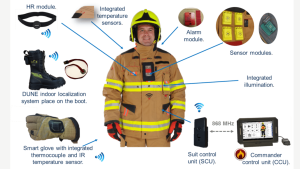Maciej Sibiński from Tallinn Institute of Technology highlights the role of flexible solar power in today’s security and rescue systems and the possibilities for the near future.
Today, certain extreme situations and activities such as far wilderness travel, extreme sports activities, terrorist attacks, pandemics, wildfires, military conflicts, and other things have become increasingly common in our lives, pose a major threat and accelerate the demand for innovative solutions. Very often, rapid and accurate rescue, proper treatment, or effective operation in these conditions is associated with modern electronic devices that can provide rapid communication, proper diagnosis, and enhanced capabilities. However, achieving this relies on stable, robust and safe energy sources that can be difficult to obtain.
The disadvantages of traditional firefighting work
Let’s take a closer look at practical examples of modern firefighting work. Traditionally, depending on the actual situation and ability, he worked independently on the field under the direction of an experienced team leader, either within the building or within the field. However, dynamic conditions such as unexpected building collapse, temperature rise and toxic gases pose a serious threat to the safety of these operations. Furthermore, working with fog conditions or toxic chemical clouds can affect situational judgments. Factors such as overstigate, stressed or overlooked can affect decision-making. So how can you effectively deal with these challenges?
Real-time surveillance to improve firefighter safety
Assume that each firefighter’s health is constantly monitored according to blood pressure, heart rate, oxygen content, skin temperature, and even sweat strength and composition. Also, the parameters of the area and movement are controlled according to external temperature levels, localization, elevation, acceleration, body position, and movement speed. The presence of toxic gases or acids, along with other information, is reported immediately by the electronic head-up display of his visor. Additionally, a constant connection between the rest of the group and the central command unit is provided continuously. Not only are each team members better known and prepared for unexpected events, but the overall firefighter work is being ordered more effectively and safely. Furthermore, the incoming threat could be a rapid temperature rise or worsening condition for the firefighters themselves, and it is clear to commanders who may decide to pull the person out of the situation.

Is it possible to get all this information in real time without any special measurement setup? The answer is yes – by today’s miracle of smart textiles and electronic microsensors. All the sensing equipment you need can be fully integrated into the inside and outside clothing in the form of microchips and flexible foil sensing stripes. Even transmission antennas can be used in the form of a screen printed circuit on the back of the jacket.
Apart from the fire department, other emergency services and rescue teams can benefit from these systems. Acceleration/motion sensors installed in the worker’s reflective vest automatically report all possible fall accidents to the central system, potentially reducing rescue and intervention times.
Flexible solar power generation: a reliable source of energy
Delivery of electrical energy is absolutely necessary to operate all of these systems. While batteries may be the obvious first idea as a power source, their weight, toxicity and unpleasant rigid construction are serious drawbacks in textile applications. Fortunately, flexible solar power generation could be the ideal solution.

Figure 3: Electronic elements printed on polymer foil samples
Figure 4: Broadband antenna printed directly on fabric
Figure 5: Smart Reflection Vest with Acceleration Sensor
Flexible solar power can easily integrate with a variety of textiles, including boat sails, tent covers, backpacks, firefighter outer clothing, and even regular clothing. Production of this integrated technology is not an easy task. This is because its demands are not only abrasion resistance and abrasion resistance, but also humidity resistance, as well as during standard washing cycles. Nevertheless, several thin-film PV technologies, including SB2S3 and SB2SE3 cells, developed at the Thin Film Energy Materials Group Laboratory at Tallinn University of Technology, offer this perspective.

Although future technological developments are required, the potential benefits of power supplies for outdoor wearable systems are extremely promising. The first products based on thin film solar power generation for these applications have already penetrated the market niche. Soon, these reinforced clothing could become the focus of our personal electronics.
understand
This work was supported by the EU Horizon 2020 Project 952509-5GSOLAR
reference
T. Blecha, R. Soukup, Petr Kaspar, A. Hamácek, J. Seboun “Smart Firefighter Protective Suit – Functional Blocks and Technology” Proc. 2018 IEEE International Assembly Electronics (ICSE) March 11-13, 2018, Barcelona, Spain M. Civisky, M. Jakubowska, M. Suuma, “Flexible Temperature Sensors of Fibers” Volume 10, Issue 9, 2010, PP 7934-7946 S. Text Ronic Applications” Material Science and Engineering B: Solid State Material Volume 165 for Advanced Technology, No. 1-2, 25 2009, pp 50-52 I. Januszkiewicz, I. Krucińska “Comparison of parameters of fiber antennas manufactured using three technologies: Magnetron Sputtering, Ink-Jet Printing and Embroidery & Textiles and Textiles and Textiles and Textiles and 32(1), 2024 pp. 1–7 Https:///swanholmtech.com/
This article will also be featured in the 24th edition of Quarterly Publishing.
Source link

